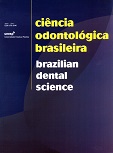Avaliação clínica do efeito adicional do verniz fluoretado sobre a inativação de lesões iniciais de cárie em dentes decíduos
DOI:
https://doi.org/10.14295/bds.2008.v11i3.510Abstract
ResumoO objetivo deste ensaio clínico foi avaliar o efeito adicional do verniz fluoretado sobre a inativação de lesões iniciais de cárie em dentes decíduos submetidos a 6 sessões de escovação profissional com dentifrício fluoretado. Critério de inclusão: mancha branca ativa (MBA) na face vestibular de incisivo/canino decíduo superior. Participaram 12 crianças (9 a 48 meses de idade), totalizando 29 MBA. As crianças foram alocadas aleatoriamente em 2 grupos: sem verniz fluoretado (SF) e com verniz fluoretado (CF). Ambos receberam 6 sessões de escovação dentária profissional com dentifrício fluoretado com intervalo médio de 1,2 semanas. O grupo CF recebeu aplicação de verniz fluoretado após cada escovação. Um único examinador cego, calibrado para cárie dentária (k=0,71) e biofilme dental (BF) (k=0,71) e treinado para sangramento gengival (SG), avaliou os dentes em: baseline, intermediário e final. Os dados foram analisados no SPSS, utilizando os testes χ2 e exato de Fisher. Ao final, 22 (5,7%) lesões foram consideradas inativas e não houve diferença entre os grupos (p=0,295). A combinação dos dados de BF e SG originou o padrão de higiene da superfície dentária (PHD) que esteve associado à inativação das lesões (p=0,010). Clinicamente, não se observou efeito adicional do verniz fluoretado na inativação das lesões de cárie. Esta esteve associada à melhora do PHD, uma vez que a maior proporção de inativação ocorreu dentre as superfícies que apresentaram melhor qualidade de higiene.
Downloads
Downloads
Published
How to Cite
Issue
Section
License
Brazilian Dental Science uses the Creative Commons (CC-BY 4.0) license, thus preserving the integrity of articles in an open access environment. The journal allows the author to retain publishing rights without restrictions.
=================




























